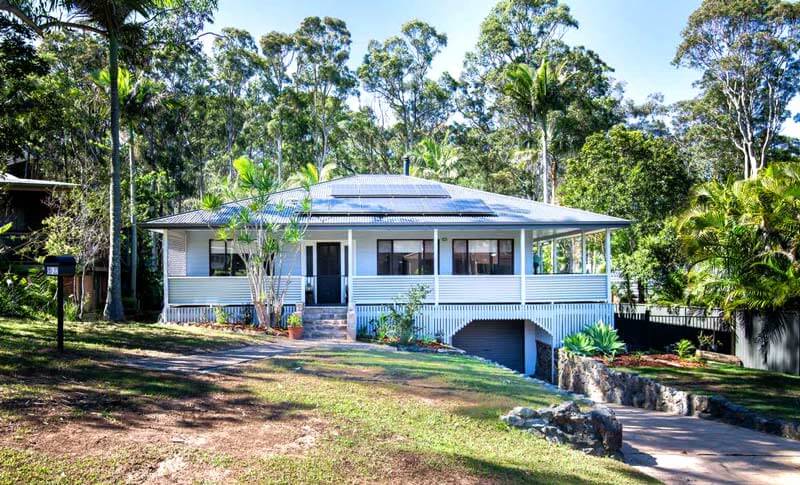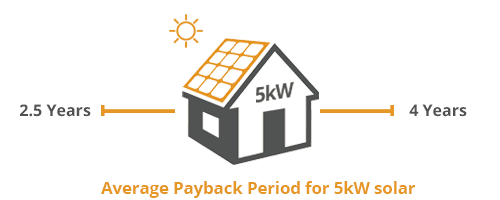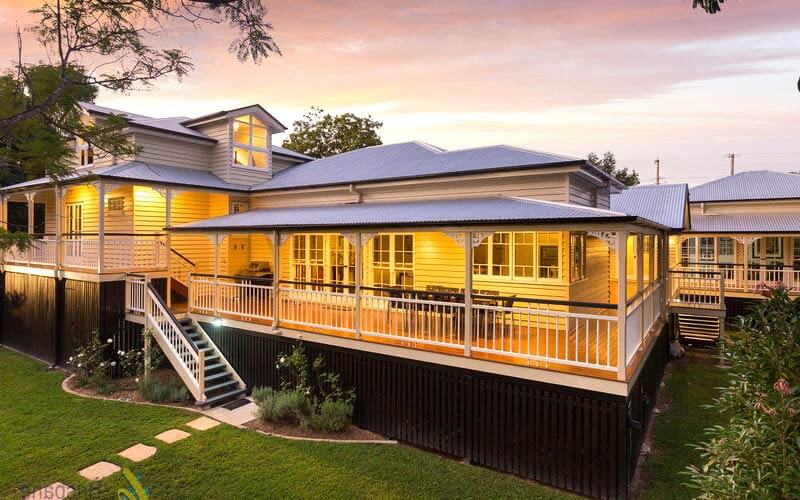Home Solar Panels Brisbane | Top Solar Installer Brisbane
Solar Panels Brisbane | Top Solar Installer Brisbane
Need help with solar panel installation in Brisbane but not sure where to start? Go Solar Quotes connects Brisbanites with top-rated, CEC-accredited local solar installers, ensuring you get the best solar system size and maximum savings tailored to the Sunshine State’s sun-rich climate.
Since 2016, we’ve helped Brisbane residents take advantage of government solar rebates and optimize feed-in tariffs, making solar energy affordable and accessible.
You’ll receive up to three quotes from certified solar professionals—quickly and with no obligation—helping you reduce your electricity bills and achieve a fast ROI. It’s never been easier to power your home and make the most of Brisbane’s abundant sunshine.
Table of Contents
ToggleSolar panel cost in Brisbane
The average cost of a solar panel system in Brisbane, QLD, is $5,560 for a 6.6kW residential system, or 30kW system will cost $26,378, a popular choice for commercial solar applications. This net price includes the QLD government rebate, which fluctuates with the Small-scale Technology certificate prices.
The size of the solar power system that is best for you will depend on your energy usage, so take a look at the average power bill in summer and winter and work out your power usage per day.
Solar panels Brisbane can easily meet your current power usage needs.
.
| Installtion Price | Rebate Amount | Net Cost |
|---|---|---|
| Solar Cost Per KW Brisbane | $632 | $1,073 |
| 3kW | $1,304 | $4,108 |
| 5kW | $2,173 | $5,748 |
| 6.6kW | $2,844 | $7,042 |
| 7kW | $3,042 | $7,499 |
| 8kW | $3,476 | $8,264 |
| 9kW | $3,911 | $8,985 |
| 10kW | $4,345 | $9,667 |
| 30kW | $11,397 | $26,378/b> |
| 50kW | $18,982 | $46,605 |

Locations we service
Redlands
Logan
Ipswich
Burleigh Heads
Coolangatta
Tweed Heads
Solar battery cost in Brisbane
The cost of a solar battery backup system will greatly depend on system size and use case for the battery.
As most households will use 30% of their power throughout the day and 70% at night, so the battery storage system needs to hold 70% of your daily usage.
A 6.6kW solar power system generates 26kW per day. With the 30/70 split means you will need to store 18 KW for use at night. A Tesla PowerWall2 stores 14kWh and costs $12,500. By managing your power usage more carefully and running washing machines, pool pumps and airconditioning at peak daytime periods, you can get away with a 14kW battery.
Government solar rebates and incentives
With the federal government STC solar rebate scheme, you will receive a rebate based on the size of your solar power system. The government solar rebate in QLD varies depending on what STC zone your city falls in. For instance, a 6.6kW solar power system gets 85 STCs (STC zone 3), which translates to $3,392.
To know the amount of your rebate in QLD, you should multiply the kW solar panels, deeming the period of your panels, zone rating, and spot STC price. The results you get will be your rebate.
The following are the government rebates in QLQ.
Solar Battery Return on Investment (ROI) and Use Cases
Adding a solar battery to your system in Brisbane can provide energy independence, especially during grid outages. Batteries like the Tesla Powerwall store excess energy generated during the day, which you can use at night, reducing reliance on the grid. However, the payback period for solar batteries is longer than panels—expect 8-10 years compared to a 3-4 year return for solar panels alone.
If you’re considering battery storage, brands like Tesla Powerwall, Enphase, and SolarEdge are top options for Brisbane households. Each comes with specific features— As mentioned Tesla’s Powerwall offers 13.5kWh storage, ideal for most residential needs. For those with larger properties or energy demands, the SolarEdge Energy Bank integrates seamlessly with existing systems, providing more flexibility on battery sizes as compared to Tesla.
Please call us on 1800 861 852 for more information on batteries and sizes.
Solar battery booster rebate
The Queensland government’s Battery Booster program is currently closed to new applications. The program stopped accepting conditional approval applications as of 8 May 2024. Households that applied before the deadline and received conditional approval have up to 90 days to install their battery systems and claim the rebate.
No current point-of-sale rebates or interest-free loans for solar battery storage are available through this program for new applicants.
Benefits of Solar Power in Brisbane
Brisbane’s sunny climate makes solar energy a no-brainer. Just take a look at some of the key benefits:
| Benefit Type | Details |
|---|---|
| Environmental Benefits | - Reduced Greenhouse Gas Emissions: Lower reliance on fossil fuels decreases greenhouse gasses. |
| - Sustainable Energy Source: Solar power is renewable and inexhaustible, contributing to a cleaner environment. | |
| - Lower Air Pollution: Using solar reduces harmful pollutants that come from traditional electricity production, helping to keep Brisbane’s air clean. | |
| Financial Benefits | - Significant Savings on Electricity Bills: Solar panels can cover a large portion of your energy needs, leading to substantial reductions in expenses. |
| - Potential Income from Selling Excess Power: Queensland programs allow for selling surplus energy back to the grid. | |
| - Increased Property Value: Solar-equipped properties are more appealing to buyers, thanks to long-term energy cost savings. |
Switching to solar in Brisbane isn’t just about saving some bucks; it’s about doing your part for the environment too.
Solar power system output in Brisbane
Different systems have different power outputs depending on where they are in Australia. Brisbane is a great location for solar as there are 280 – 300 dayes of sunshine each year, making it perfect for solar. The system you choose should be enough for he number of people in your household with the only restriction being enough north-facing roof space.
| System Size | Output |
|---|---|
| 1kW | 4.3kWh |
| 1.5kW | 6.45 kWh |
| 3kW | 8.6 kWh |
| 3kW | 12.9 kWh |
| 4kW | 17.2 kWh |
| 5kW | 21.5 kWh |
| 6kW | 25.24 kWh |
| 10kW | 38.5kWh |

Solar Rebate Calculator
Let us help you choose the right solar system for your home or business
Let us match you with the best 3 top-voted solar installers in Brisbane. Just fill in this 2-minute form, enter your;
- Postcode
- Power requirements
- Contact details
And we ask local solar installers to send you a free quote. This is an obligation-free service. Just friendly advice and great prices.
Average ROI and payback period for Brisbane solar
The payback period for the average solar power system in Brisbane is 4 years. Households that decide to add solar batteries, will see the payback period stretch to 10 years.
Payback periods are calculated based on the energy cost or the per kW price you pay from your energy retailer and the amount of energy your solar power system produces in the Brisbane sunshine.
Feed-in tariffs are also a big part of this and can reduce payback periods by half.

Residential vs. Commercial Solar Solutions
Thinking about going solar? Whether you’re looking to cut down on your household electricity bills or slash the energy costs for your business, there’s a solar solution that fits.
Residential and commercial setups come with their own perks, so it’s all about finding the right fit for your needs. Here’s a quick rundown to help you decide.
| Category | Residential Installations | Commercial Installations |
|---|---|---|
| System Sizes | Typically range from 5kW to 10kW, which is great for most households. | Larger systems, often 30kW or more, to handle business energy needs. |
| Benefits | Slash your electricity bills and boost your home’s value. | Cut down on operational costs and keep your business running smoothly. |
| Specific Requirements | Roof space and how much energy you use are key factors. | Need to consider roof space, energy patterns, and business hours. |
Whether you’re powering your home or your business, solar can deliver serious savings.
Warranties and After-Sales Service
Installing solar is a long-term investment, and knowing you have a solid warranty can provide peace of mind. We offer a 25-year warranty on our solar panels and a 10-year warranty on inverters, covering both product performance and workmanship. This ensures your system continues to operate efficiently for years, even in Brisbane’s extreme weather conditions.
Our after-sales service can include annual maintenance checks and system performance monitoring, so you know everything’s running smoothly.

Solar Feed-in tariffs for Brisbane QLD
If you are looking for the best Feed-in tariff in QLD, ensure you select the best provider to get the best rewards. Different providers offer different rates, and the rates also depend on the size of your solar.
Below are some of the best FiT providers you should consider working with to save your surplus energy.
Best Overall

| Min FiT | Max FiT |
|---|---|
| 11.2c | 16c |
Click Energy is another great provider that awards you a minimum of 11c per kWh and a maximum of 16c per kWh. It is one of the best FiT providers in Australia, and it will award you every cent for your energy.
So, if you want a reliable FiT provider, Click Energy should be on top of your list.
Runner up
| Min FiT | Max FiT |
|---|---|
| 10.2c | 10.2c |
Red Energy is one of the best in the market as it offers outstanding rates per kWh. For every kWh, you will receive 10.2c. This is a good solid market price from this well-known market leader in green energy.
With Red Energy, you will be able to conserve excess power and get paid for it. You will, therefore, be able to reduce the payback time of your system.
Great All-rounder
| Min FiT | Max FiT |
|---|---|
| 8.5c | 44c |
DoDo is another great FiT company worth your consideration. It offers a minimum of 8.5c and a maximum of 44.0c, which is a great offer for your surplus energy. This provider is reliable, and it will not lock you into an unwanted contract. This means you have all the power to stay or move at any time.
Solar installation for renters in Brisbane
Residents in Brisbane can’t install solar systems on rental properties they live in. The Queensland state government has announced a solar for rentals trial to encourage landlords to install solar. With 35% of homes in Brisbane occupied by tenants, this is a necessary gap in the market to bridge.
Government Programs for Renters
While homeowners benefit significantly from solar, renters in Brisbane often miss out. To bridge this gap, the Queensland government has launched the “Solar for Rentals” trial, encouraging landlords to install solar on rental properties. With over 35% of Brisbane households rented, this program is a crucial step towards making solar accessible for everyone.
Renters can now negotiate with landlords to participate in the trial, which offers incentives for installing solar systems on rental properties, reducing energy costs for tenants while increasing property value for landlords.
What should I look for when hiring Brisbane solar installer?
When selecting a solar installer in Queensland, you need to pay attention to a few key areas to be sure you are getting a quality system from an expert installer at reasonable market prices.
Accredited – Solar installers in Brisbane need to have Clean Energy Council CEC accreditation. They should also have a License number which is displayed on their quotation.
Experience – Using a solar company with more than five years of installing solar panels is a good sign. Fly-by-night companies usually go out of business in a year or two, so anyone still in the game after five years is a sure thing.
Market reputation – Check their rating across various platforms. Don’t just check one source like Google reviews; check 3 or 4 and make sure their rating is consistent. I’ve seen many companies abandon Google reviews and promote their True Local reviews because they were scalded by previous companies on that platform.
Market knowledge – Having a fine minute conversation with a solar installer will alert you to their knowledge base and should have you feeling confident you are in good hands. If they don’t seem too sure of themselves, it’s probably best to move on.
Offers more than one system brand – Find a company offering different solar panels and inverters. That way, you can go with mid or high-quality equipment.
Competitive prices – Be sure to get at least three quotes before deciding on a company. I’ve heard too many stories of customers going with the first company that quotes their job and paying way too much for a poor-quality system.
FAQs
What Factors Should I Consider When Choosing a Solar Panel Installer?
It’s important to look at the installer’s qualifications, customer reviews, and warranties offered. Make sure they’re accredited, which guarantees they meet industry standards. Local experience is also crucial—installers who know Brisbane’s regulations will ensure your system is up to code and set up for optimal performance.
Plus, reputable installers often provide better after-sales service.
Optimal solar panel orientation and angle in Brisbane
The optimal solar panel orientation is true north and about 28 degrees. The panels receive a lot of sunlight at this angle, making it the perfect angle for most households. A 10-degree tilt may be added to allow the panels to self-clean whenever it rains.
Are solar panels worth it?
Yes, solar panels are worth it because you will be able to reduce or eliminate your monthly and annual electricity bills. Although the installation cost is high, you can buy a good system and benefit from the state incentives. You can also find a good FiT provider that will help you reduce the systems’ payback time.
What is the maintenance cost of solar panels?
The average yearly maintenance cost of solar panel systems in Brisbane is $125. Solar panels are relatively low maintenance but occasionally will need a wash for max light penetration if they get dusty or covered in bird droppings.
It is recommended to keep panels clean as it keeps your system operating at peak performance and to use a professional service. If you use the wrong product, you can damage your panels.
Are There Any Restrictions on Where Solar Panels Can Be Installed?
Solar panels should be installed in areas with minimal shading for maximum efficiency, ideally on a north-facing roof in Brisbane.
Your roof also needs to be structurally sound to support the system. If there’s significant shading or your roof needs repairs, those issues should be addressed first to avoid affecting the panels’ performance.
Can I Add a Battery to My Solar Panel System Later?
Absolutely. You can add a battery anytime to store extra energy and use it when you need it most, like at night or during an outage. It’s an easy upgrade whenever you’re ready.
How Do Solar Panels Perform on Cloudy or Rainy Days?
They still work, just not as well as on sunny days. Output drops a bit, but if you’ve got a battery, it can keep you covered during those low-production periods.
Compare Solar Panel Quotes
Table of Contents
Toggle









